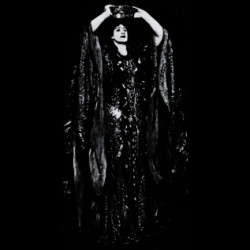This delegation is not a product consigned to the ‘60s and Roy and John, but to all mystical traditions as mentioned earlier. Wicca asserts an imbalance through its negation of the male and male deific status. CTC does not worship the Goddess; in fact it seeks gnosis that results only from the understanding that occurs when such false notions are aborted. Our Mysteries generate the process of evolution.
Naturally, when a Magister is without a Maid, he retains Virtue, but as an unbalanced force, not because he is male but because he is unable to express the mysteries by himself within a Clan context. This does not negate his personal ability to access and fulfill his own evolution through neuter spirit as an individual. But for those within his Clan, for whom he represents and embodies its Tutelary Deity, he manifests what she mediates. He thus becomes the Lord of this World and she the heavenly or otherworld noumena. These roles cannot be reversed through our male and female sex based units, although they are experienced via their dedicated gender based mysteries.
Some, though by no means all, Traditional groups uphold this archaic formulae of Covenanted, feudal, and archaic Suzerainty. Those most likely to follow a more andro-centric locus are predictably the ones based in the late 18th-century crafts and guilds of Horsemen, traditions of Cunning-men, Pellars, and such forth. Generally speaking (and again there are exceptions) these tend not to have such mystical aspirations as those that follow the more archaic traditions of the Luciferian Stream. Robert Cochrane was torn between the two. On the one hand, his family upheld the code of the horsemen and pellars, but he received a more inspired download from a more archaic place. With John's help and substantial input, he was able to formulate a vibrant Tradition, fueled by a primal force, yet accessible through a conventional Compass, effectively anchoring the Mysteries within it.
Robert Cochrane makes mention of the Angel of Light in his letters, and in an interview with Michael Howard, you stated that there is, unreservedly, a Luciferian element in Clan Tubal Cain. I think that the majority of our readers probably have a Christian background, and the minute the name Lucifer is mentioned, all sorts of alarm bells go off. Is Lucifer the same as the Christian Satan? Who do you understand Lucifer to be and what role does he play in Traditional Craft?
An excellent question. Let me offer my considered musings that will hopefully negate these querulous concerns. There are many religions the world over that have, since their inception, subverted the gods of opposing faiths into demons or even the devil, the dark bogeyman of all bad novels, nightmares, and ‘B' movies. Nevertheless, the energy and beliefs attributed to these thought forms are diametrically opposed to that invested by the adherents of those blighted and maligned faiths; and so a duality arises. Again it is the duty of all occultists to clarify this discrepancy and for the True Craft to distance itself from the promotion of false and negative imagery. The knowledge not just how to live but how to die, how to prepare for death, how to be, to become, how to extend our mortal limitations; these are the gifts of the True Craft, the bounty of Cain, the Father of all.
It is worth reiterating that no concept of a devil existed in the time of Isaiah (Is. 14:12). Neither in fact, does his much misappropriated personage, Hel-el ben Shahar, bear any associations with Venus. English literature records its earliest references to Lucifer as Satan c. 1000 C.E. and as the Morning Star as late as c. 1050 C.E.
Lucifer, however, is not Satan; He never was. Neither was Satan ever the Devil. Such blind prejudice jeopardizes the value of Truth in face of the perpetual Lie. The Christian Devil is a fictional construct, a symbol formed as a theological necessity for an insecure Church during a time of socio-religious turmoil. This personage provided a rod with which to subdue unruly pagans ripe with superstitions and correlate mythologies. Fear made the populace gullible, so much so that even now in the wake of rationalism, many blithely adhere to illusion and falsehoods.
Several revisionist bibles indiscriminately use the term Lucifer, daystar and morning star, except the NWT, which substitutes a more enlightened and accurate translation of the Masoretic phrase into Shining One. Modern parlance and word comprehension suffers many perversions from original meanings and use. To those contexts we should apply our analyses as scholars. Hel-el could mean God of the Sun, but it more properly means simply bright one or shining one.
Three patterns developed the character and form of Lucifer as the Devil. The first, of theology, was inspired by Persian dualism suggesting the concept of Satan as a figure of evil, separate and distinct from God; second, the psychological aspect of free will allowed angels, including the fallen, to choose their allegiances; and finally, the historical abuse of myth contributed. Heaven and Hell as places of reward and punishment inhabited by human beings, rather than realms of upper and underworld gods, was yet another consequence of Persian dualism.
Lucifer is the prime avatar, whose light of gnosis is the source of evolution for mankind. He reveals the blinding Truth. The Craft holds within its core a religion at once profound and sublime and for those of us who share these principles of enlightenment, the light extends from the dark; it is not covered by it.
Part Two of this interview can be found here.
Reprinted with permission from Penton Independent Pagan Media.




